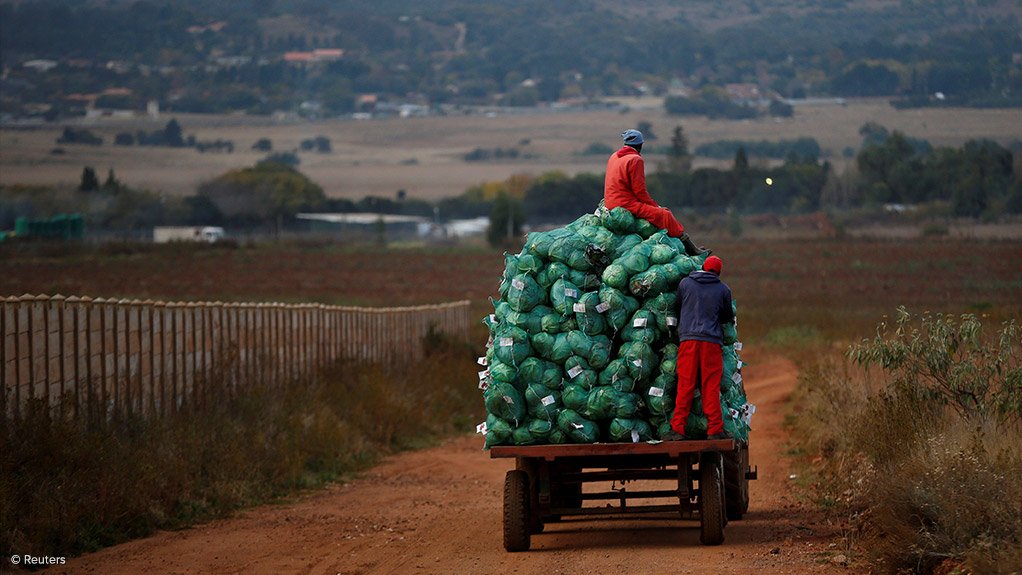South African food inflation continued to decrease in July, but still far above CPI inflation
The Bureau for Food and Agricultural Policy (BFAP) has, in its latest 'Food Inflation Brief', highlighted that South Africa’s food and non-alcoholic beverage (NAB) inflation – hereafter to be referred to simply as food inflation – continued to decelerate in July. However, it also remained far above the rate of consumer price index (CPI) headline inflation. Year-on-year (y-o-y), food inflation in July was 9.9%, which was 1.1 percentage points below June’s y-o-y figure of 11%. However, the CPI headline number in July was 4.7%. In contrast, in month-on-month (m-o-m) terms, food inflation in July was 0.2%, but CPI headline inflation was 0.9%. In July, food inflation contributed 1.7 percentage points to the y-o-y CPI headline inflation figure. In m-o-m terms, however, its contribution was zero percentage points.
Of relevance to various agricultural inputs, in July the rand:dollar exchange rate was R18.19/$1.00, which was an 8% deterioration, y-o-y. And while the CPI index for fuels dropped 16.8%, y-o-y, that for “electricity and other fuels” rose by 14.7%. The continuing scheduled rotating power cuts, called loadshedding, were a challenge, the BFAP pointed out.
The food categories which recorded the highest y-o-y inflation in July were sugar-rich foods (18.7%), vegetables (18.5%), dairy and eggs (14.4%), bread and cereals (13.1%), fish (8.8%), NAB (also 8.8%), meat (5.1%), and fruit (2.6%). Oils and fats recorded y-o-y deflation of 12.9%. In m-o-m terms, the highest food inflation was experienced by sugar-rich foods (2.5%), followed by fruit (1.4%), fish (0.9%), meat (0.4%), and bread and cereals (0.3%). Deflation was reported for NAB (0.3%), vegetables (0.5%), dairy and eggs (also 0.5%) and oils and fats (0.6%).
The food items which experienced y-o-y inflation in July equal to or greater than 30% were (in the order given by the BFAP) onions, potatoes, and frozen potato chips; and Ceylon/black tea. Those with inflation from 20% to just under 30% were instant noodles, cheddar cheese, pineapple, cauliflower, pumpkin, sweet potatoes, white sugar, brown sugar, tomato sauce, salad dressing, and fruit juice concentrates. Food items with inflation from 10% to just under 20% were wheat flour, maize meal; beef fillet, corned beef; pork fillet, bacon, polony; chicken (fresh, frozen but not individually quick frozen) giblets; polony (listed again); fish (frozen hake, fish fingers, canned pilchards); condensed milk, yoghurt, gouda cheese, feta cheese, cream, sour milk, custard, mageu (a traditional indigenous NAB made from fermented maize porridge); apples, papaya; cabbage, broccoli, mushrooms; sugar-rich foods; vinegar, mayonnaise, salt, spices, soup powder; and, coffee, hot chocolate, mineral water and fruit juice.
Food items which saw y-o-y deflation in July were (again in the order given by the BFAP) rice; beef brisket, chuck, T-bone, “stew”; mutton/lamb leg, “stew”; eggs; sunflower oil and canola oil; oranges, avocados; lettuce, sweet peppers, beetroot; and, dried beans.
In July, the BFAP’s Thrifty Healthy Food Basket (THFB) cost R3 552, which was a y-o-y increase of R345, or 9%. However, in m-o-m terms the July number was a decrease of R29, or a decline of 0.8%. The THFB is composed of 26 food items from all the food groups and is nutrionally balanced. It is designed to feed a family of two adults, one older and one younger child, for a month. Assuming that family is earning two minimum wages, is receiving child grants and benefitting from school meals, in July buying the THFB would have consumed 30.9% of the family’s income.
“The volatility and general weakening in the Rand exchange rate over the first half of the year has been a critical driver of food inflation,” pointed out the BFAP. “While expectations are that food inflation rates will continue to moderate over the coming months, the exchange rate will be a key determining factor, as will other costs through the value chain and the intensity of loadshedding.”
Comments
Press Office
Announcements
What's On
Subscribe to improve your user experience...
Option 1 (equivalent of R125 a month):
Receive a weekly copy of Creamer Media's Engineering News & Mining Weekly magazine
(print copy for those in South Africa and e-magazine for those outside of South Africa)
Receive daily email newsletters
Access to full search results
Access archive of magazine back copies
Access to Projects in Progress
Access to ONE Research Report of your choice in PDF format
Option 2 (equivalent of R375 a month):
All benefits from Option 1
PLUS
Access to Creamer Media's Research Channel Africa for ALL Research Reports, in PDF format, on various industrial and mining sectors
including Electricity; Water; Energy Transition; Hydrogen; Roads, Rail and Ports; Coal; Gold; Platinum; Battery Metals; etc.
Already a subscriber?
Forgotten your password?
Receive weekly copy of Creamer Media's Engineering News & Mining Weekly magazine (print copy for those in South Africa and e-magazine for those outside of South Africa)
➕
Recieve daily email newsletters
➕
Access to full search results
➕
Access archive of magazine back copies
➕
Access to Projects in Progress
➕
Access to ONE Research Report of your choice in PDF format
RESEARCH CHANNEL AFRICA
R4500 (equivalent of R375 a month)
SUBSCRIBEAll benefits from Option 1
➕
Access to Creamer Media's Research Channel Africa for ALL Research Reports on various industrial and mining sectors, in PDF format, including on:
Electricity
➕
Water
➕
Energy Transition
➕
Hydrogen
➕
Roads, Rail and Ports
➕
Coal
➕
Gold
➕
Platinum
➕
Battery Metals
➕
etc.
Receive all benefits from Option 1 or Option 2 delivered to numerous people at your company
➕
Multiple User names and Passwords for simultaneous log-ins
➕
Intranet integration access to all in your organisation




















